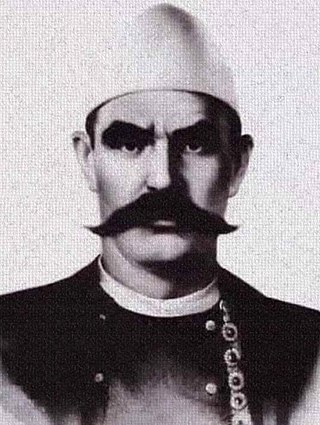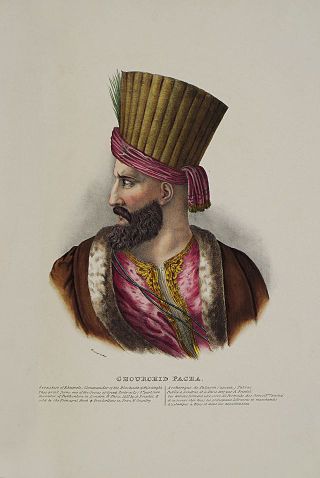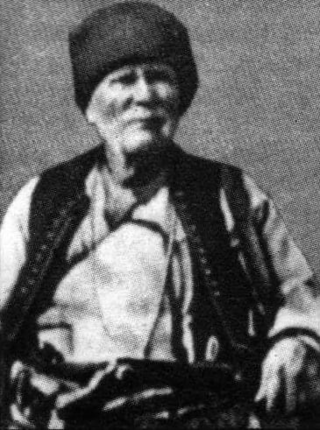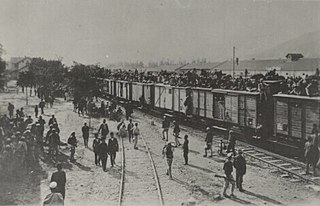Related Research Articles

Gjakova is the seventh largest city of Kosovo and seat of Gjakova Municipality and Gjakova District. The city has 40,827 inhabitants, while the municipality has 94,556 inhabitants.

Bajram Curri was an Albanian chieftain, politician and activist who struggled for the independence of Albania, later struggling for Kosovo's incorporation into it following the 1913 Treaty of London. He was posthumously given the title Hero of Albania.

Sulejman Vokshi, also known as Sul Vokshi, was an Albanian military commander and a leader of the League of Prizren. As a member of the central committee of the league, particularly as the head of the finances commission, Vokshi was also an important leader of the organization's military branch and an officer of its military staff.

Hurshid Ahmed Pasha was an Ottoman-Georgian general, and Grand Vizier during the early 19th century.

Ali Pasha Shabanagaj was an Albanian Muslim military commander and one of the leaders of the League of Prizren. He governed, as an Ottoman kaymakam (sub-governor), an area in what is today eastern Montenegro around Plav and Gusinje. He was commonly known as Ali Pasha of Gusinje. He was the leader of the Albanian irregular troops of the League of Prizren against the Principality of Montenegro at the Battle of Novšiće. He was governor of the area of Plav and Gusinje located in a valley between steep mountains.

Idriz Seferi was an Albanian leader and guerrilla fighter (rebel). During his 56 year military career, he fought in 35 battles. A member of the League of Prizren and League of Peja, he was the right-hand man of Isa Boletini, with whom he organized the 1910 Uprising against the Ottoman Empire in the Kosovo Vilayet. After the suppression of the uprising, Seferi continued warfare, in the 1912 Uprising. In the First Balkan War, Boletini and Seferi rose up against Serbia, with whom they had previously been allies to during the 1910 and 1912 Uprisings, and continued to attack Serbian posts in the subsequent occupation and initial phase of World War I (1913-1915). In the second phase of the war (1916-1918), he led troops against Bulgarian forces.
Riza Kryeziu (1847-1917), known as Riza Bey Gjakova, was an Albanian nationalist figure and guerrilla fighter, an influential bey in the Gjakova region, then part of the Vilayet of Kosovo, Ottoman Empire, and one of the activists of Albanian national movements of early 20th century.
The Massacre of the Albanian beys occurred on 9 August 1830, when around 500 Albanian leaders (beys) and their personal guards were killed by Ottoman forces in the town of Manastir. The massacre led to the weakening of the power of the beys of southern Albania and also set the basis for the destruction of the powerful northern Albanian Pashalik of Scutari.
The Uprising of Dervish Cara was a 19th-century uprising in northern Ottoman Albania directed against the Ottoman Tanzimat reforms which started in 1839 and were gradually being put in action in the regions of Albania. Some historians include the actions in Dibër of the same time under the same historical name, though the events in Dibër were independent and headed by other leaders.
The Albanian revolts of 1833–1839 took place in Albania as a reaction against the new centralizing policy of Ottoman administration.

The Albanian revolt of 1912, was the last revolt against the Ottoman Empire's rule in Albania and lasted from January until August 1912. The revolt ended when the Ottoman government agreed to fulfill the rebels' demands on 4 September 1912. Generally, Muslim Albanians fought against the Ottomans in the incoming Balkan War.

Krasniqi is a historical Albanian tribe and region in the Accursed Mountains in northeastern Albania, bordering Kosovo. The region lies within the Tropoje District and is part of a wider area between Albania and Kosovo that is historically known as Gjakova highlands. Krasniqi stretches from the Valbona river in the north to Lake Fierza in the south and includes the town Bajram Curri. Members of the Krasniqi tribe are also found in Kosovo and Northern Macedonia.

Gashi is an Albanian surname and the name of one of the major historical tribes of northern Albania. It is a historical tribal region situated in the Highlands of Gjakova. The Gashi tribe is known to follow the Kanuni i Malësisë së Madhë, a variant of the Kanun. They were known among the mountain tribes for their wisdom.
The Albanian revolt of 1845, known Revolt of 1845 between Albanians was one of the 19th-century uprisings in Ottoman Albania directed against the Ottoman Tanzimat reforms.
Zef Kol Ndoka (1883-1924), also known among Albanians as Zefi I Vogël, was an Albanian warrior and commander from the Shengji family from today's Fan Mirdita in Northern Albania.
The Battle of Lumë, also referred by the Albanians as the Uprising of Lumë, was a series of clashes between the Albanian locals of the region of Lumë in Ottoman Albania against the invading Serbian army in 1912 during the First Balkan War period. As the Kingdom of Serbia sought to gain access to the Adriatic Sea, the Serbian army met significant resistance from Albanian militia in the Luma region, resulting in the defeat of the Serbian forces. In securing the central Adriatic coast in Albania, Albanian political figureheads were able to disembark in Durrës and proceed with their plans for the eventual Albanian Declaration of Independence.
Mahmut Pasha of Begolli or Mahmut Pasha was an Ottoman Albanian military commander of the Begolli family and Pasha of Peja, Sanjakbey of Dukagjin and later Beylerbey of Rumelia The Albanians participated in the siege of Vienna in 1683 as the personal bodyguard of Grand Vizier Kara Mustafa. Mahmut Pasha is a heroic figure in Albanian folklore and oral tradition.

Botushë is a village in the municipality of Gjakova, District of Gjakova, southwest Kosovo. It is located near the border with Albania and is part of the Highlands of Gjakova. It is inhabited exclusively by Albanians.
The Taksim meeting alternatively known as the Taksim Plot and less commonly as the Taksim Assembly was a secret meeting held in January 1912 by Albanian nationalist deputies of the Ottoman parliament and other prominent Albanian political figures. The event gets its name from Taksim Square because of the location of the house where it was held. The meeting was organized on the initiative of Hasan Prishtina and Ismail Qemali, Albanian politicians, who invited most of the MPs of Albanian origin and aimed at launching an armed general uprising in Albanian territories against the central government headed by the Committee of Union and Progress (CUP). The meeting followed two other Albanian uprisings of 1910 in the Vilayet of Kosovo and 1911 in the mountains of upper Shkodra. The Taksim meeting resulted in an uprising the same year, with armed uprisings in Shkodër, Lezhë, Mirditë, Krujë and other Albanian provinces, which exceeded the organizers' expectations. The biggest uprising was in Kosovo, where the rebels were more organized and managed to take over important cities like Prizren, Peja, Gjakova, Mitrovica and others.
Sulejman Aga Batusha or Sulejman Aga Botusha was a prominent Albanian resistance fighter and revolutionary leader from the Highlands of Gjakova and the wider Gjakova region who participated in the Albanian National Awakening. Born sometime in the 19th century, Sulejman Aga would repeatedly lead Albanian forces against the Ottomans throughout the 19th and 20th centuries, ultimately contributing to the Albanian Declaration of Independence from the Ottoman Empire. He was also a chief of the Gashi tribe and was their head in the Gjakova region.
References
- ↑ "Pasi ishte ekzekutuar, iu bë trupi copë-copë - Lajme - Kosova Sot". Kosova Sot.
- ↑ "Gjakova Portal".
- ↑ Bytyçi, Xhevdet. "P Ë R M B L E D H J E 1200 TEKSTE KËNGËSH SHQIPE TË MUZIKËS POPULLORE DHE ARGËTUESE" (PDF). Archived from the original (PDF) on 2020-11-29. Retrieved 2017-07-21.
- ↑ Ali Hadri (1976). Kosova. Enti i Historisë së Kosovës. p. 245.